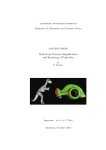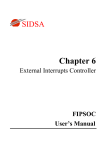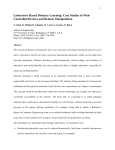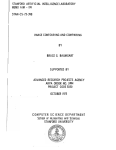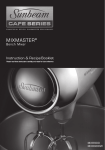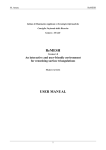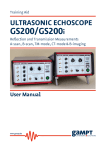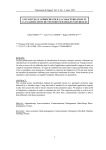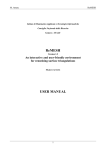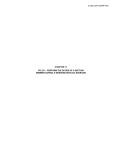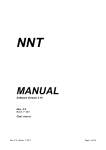Download Object reconstruction and 3D mosaicing Outline
Transcript
ARROV. Project GRD1-2004-180601
Page 1 of 42
Document ID: DISI-ARD-012
Deliverable 5.1
Object reconstruction and 3D mosaicing
Author
(UNIVR)
U. Castellani, A.Fusiello, V.Murino
(DISI)
L.Papaleo, E.Puppo, M.Pittore
Date: Friday, 02 July 2004
Outline
INTRODUCTION: WP5 OBJECTIVES.............................................................................................................................. 2
1
ONLINE RECONSTRUCTION AND MOSAICING................................................................................................ 3
1.1
1.1.1
1.1.2
1.1.3
1.2
1.3
1.3.1
1.3.2
1.3.3
1.3.4
1.4
1.5
1.5.1
1.5.2
1.5.3
1.5.4
1.6
1.6.1
1.6.2
1.6.3
1.7
1.8
2
ARCHITECTURE ...................................................................................................................................................... 3
Input .................................................................................................................................................................. 5
Output ............................................................................................................................................................... 5
Parameters........................................................................................................................................................ 6
THRESHOLDING ...................................................................................................................................................... 7
SINGLE FRAME RECONSTRUCTION ......................................................................................................................... 8
Step 1 : Find connections for non-vacant entries.............................................................................................. 9
Step 2 : Recovery vacant entries ..................................................................................................................... 10
Step 3: Improve connections, find feasible semi-diagonals............................................................................. 12
Step 4: Mesh generation.................................................................................................................................. 13
FILTERING ............................................................................................................................................................ 14
FAST REGISTRATION ............................................................................................................................................. 16
Reverse calibration approach ......................................................................................................................... 16
Subsampling.................................................................................................................................................... 18
Pre-alignment ................................................................................................................................................. 18
Speed vs. accuracy .......................................................................................................................................... 18
MOSAICING .......................................................................................................................................................... 19
Phase 1: Rasterization and Intersection Management.................................................................................... 21
Phase 2: Fusion .............................................................................................................................................. 23
Phase 3: Mesh generation............................................................................................................................... 24
LAZY UPDATE ....................................................................................................................................................... 24
USER MANUAL ...................................................................................................................................................... 25
OFF-LINE DATA PROCESSING............................................................................................................................. 25
2.1
2.2
2.3
ACCURATE PAIRWISE REGISTRATION .................................................................................................................... 26
PRE-MOSAICING.................................................................................................................................................... 27
GLOBAL REGISTRATION ........................................................................................................................................ 28
3
MULTI-RESOLUTION REPRESENTATION........................................................................................................ 31
4
REFERENCES ............................................................................................................................................................ 32
Department of Computer Science – University of Genova
www.disi.unige.it
1
ARROV. Project GRD1-2004-180601
Document ID: DISI-ARD-012
Page 2 of 42
Deliverable 5.1
Introduction: WP5 Objectives
Develop and establish methods for: 3D object reconstruction from sensor data acquired at either a
single location, or multiple locations (mosaicing); multi-resolution representation of reconstructed
objects.
3D reconstruction occurs through a sequence of operations that process input range maps to build the
mosaic mesh. The following software components are present both in the on-line and in the off-line
version, possibly with different characteristics and implementation on the two versions:
1. Data thresholding: raw data in input are filtered on the basis of sensor intensity values to
discard those data that appear to be spurious;
2. Single frame reconstruction: a mesh of triangles is built for each frame, which interpolates
range data from that frame only;
3. Mesh filtering: each single frame mesh is filtered by eliminating small connected components;
4. Registration: meshes from different frames are registered in the same coordinate system;
5. Mosaicing: registered meshes are used to compose the mosaic mesh.
The 3D object reconstruction software comes in two versions: on-line and off-line.
The on-line version is intended for use during ROV operation to provide feedback to the pilot
on the scene spanned by sensors. In this version, stress is on fast methods that can support realtime operation.
The off-line version is intended for use during surveying sessions on data collected previously.
In this case, stress is on accurate methods that can provide high quality models.
The on-line version of reconstruction consists of a strictly sequential execution of the above five
components. These components might be pipelined in a multi-processor architecture. However, in the
rest of this document, we will refer to a single processor implementation that communicates with the
Data Acquisition and Pre-processing module and the POLECAT System through a software interface
as specified in [1] . The main difference between the on-line and the off-line version is in the
registration task:
•
in the on-line version registration is made only pairwise (one frame with respect to the
previous frame);
•
in the off-line version, registration is made globally (each frame with respect to all other
frames that overlap with it).
Department of Computer Science – University of Genova
www.disi.unige.it
2
ARROV. Project GRD1-2004-180601
Document ID: DISI-ARD-012
Page 3 of 42
Deliverable 5.1
In the off-line version, a preliminary pairwise registration and data fusion (which is part of the
mosaicing task) is necessary in order to provide a map of overlap among different frames, which is
used next for global registration. Therefore, the off-line version consists of a sequential execution of
steps: 1, 2, 3, 4a (pairwise), 5a (partial), 4b (global), 5b (global). Mosaicing is indeed obtained by
modifying the on-line version and integrating it with the global registration software developed to this
specific purpose.
In the following two sections, we describe separately the architectures of the on-line and off-line
versions and related components, focusing also data exchange with other software modules, data
exchange among different components, as well as parameters that need to be set by the user (through
GUI).
Multi-resolution representation is intended for off-line use. Its main purpose is to speed-up the
visualisation of large meshes (e.g., sea beds or mosaics build during previous survey sessions) by
concentrating the level of detail only where it is necessary, and discarding detail elsewhere. The multiresolution software consists of: one construction module, which builds the multi-resolution model; and
a library to build applications that query the multi-resolution model and obtain meshes at different level
of detail for their purposes. One example is a viewer that queries the multi-resolution model at each
frame to obtain meshes clipped at the view frustum and with a resolution decreasing with distance from
the viewpoint. The multi-resolution software is described in Section 3.
1 Online Reconstruction and Mosaicing
1.1 A RCHITECTURE
The aim of this section is to describe in details the ARROV on-line data processing scheme. The main
goal of this data processing is to construct a model of the underwater environment and to track the
ROV’s motion or pose based on the processing of acoustic images, optical images and the pose
information from the motion sensors.
The program for on-line 3D reconstruction receives in input a sequence of frames and produces a
corresponding sequence of mesh updates (Figure 1). The program is endowed with a GUI that allows
the user to set a number of parameters used during processing. Note that the complete mosaic, built on
all meshes received, is maintained as a state of the program, rather than given in output. The GUI
allows the user to download the whole mosaic on disk by either interrupting or terminating on-line
operations
Department of Computer Science – University of Genova
www.disi.unige.it
3
ARROV. Project GRD1-2004-180601
Page 4 of 42
Document ID: DISI-ARD-012
Deliverable 5.1
Figure 1 - Data Processing Scheme
Department of Computer Science – University of Genova
www.disi.unige.it
4
ARROV. Project GRD1-2004-180601
Document ID: DISI-ARD-012
Page 5 of 42
Deliverable 5.1
1.1.1 Input
A frame consists of the following data:
• A time stamp, in the form of a non-negative integer value
• A range map, in the form of two bi-dimensional arrays of size 64×64:
o Each entry in the first array contains a 3D point in the form of three Cartesian
coordinates x, y, z (each being a signed integer on 16 bits) referring to a right-handed
coordinate system centered at the sensor, with axes oriented as follows:
• x – pointing from the sensor face and out, perpendicular to the face of the
receiver array;
• y – horizontal, pointing to the left when looking in the viewing direction;
• z – vertical, pointing upward.
o Each entry in the second array contains an intensity value in the form of a non-negative
integer value (unsigned integer on 8 bits – optionally this may be extended to 16 bits).
• Pre-registration information, in the form of a 4×4 matrix of real (double) values. The matrix
represents a rototranslation in homogeneous coordinates (actually, only the first three rows of
the matrix are necessary, the fourth row being fixed). A point from the range map, when
multiplied by this matrix, becomes represented in a global coordinate system.
In order to reduce the size of data exchanged between the Data Acquisition and Pre-processing module
and the other modules, the possibility will be considered to compress the range map prior to
transmission, and decompress it prior to local storage, by the following mechanism:
• The array of intensities is run-length encoded. This kind of compression is likely to be effective
since this array contains many zero values. Intensity values are transmitted first.
• Only points corresponding to non-zero intensity values are transmitted. Delta encoding of point
coordinates may be also considered.
A statistical analysis of time saved during transmission vs additional time spent for
compression/decompression is necessary to estimate the advantages of this mechanism.
Compression/decompression will be managed by interface methods provided by the Data Acquisition
and Pre-processing module.
1.1.2 Output
A mesh update consists of the following data:
• A time stamp, same as in input
• A list of meshes. Each element of the list is a mesh, which consists in turn of the following
data:
o A name, in the form of a positive integer number. We may initially assume that just one
new mesh is generated at each frame: in this case the name of each mesh is the time
stamp of the frame that generated it first.
o The number of triangles in the mesh, in the form of a positive integer number.
o A list of triangles, where each triangle is a triple of points and a point is, in turn a
triple of Cartesian coordinates (x,y,z) in a global coordinate system, each coordinate in
the form of a real number (float).
Department of Computer Science – University of Genova
www.disi.unige.it
5
ARROV. Project GRD1-2004-180601
Document ID: DISI-ARD-012
Page 6 of 42
Deliverable 5.1
A list of meshes may possibly be empty, which means that no new parts of mosaic have been
generated at the current frame.
• A 4×4 registration matrix in homogemeous coordinates (it is sufficient to transmit the first
three rows of the matrix), each coordinate in the form of a real number (double, because
precision is important in this case), which describes current position and orientation of the
sensor in a global coordinate system.
Graphical Viewers of the POLECAT System will maintain the current mosaic as a collection of
meshes, each mesh having the same structure described above. Meshes received by a Viewer at a given
frame can be of two kinds:
• New mesh: a mesh that was generated in the current frame. In this case, this mesh must be
added to the collection held by the Viewer.
• Modified mesh: a mesh, which was generated in a previous frame and modified in the current
frame. In this case, this mesh must substitute the mesh having the same name in the collection
held by the Viewer. An empty mesh, i.e., a mesh with zero triangles, means that the mesh with
the same name must be deleted from the collection held by the Viewer.
A modified mesh can be discriminated from a new mesh based on existence of its name in the
collection of meshes that form the current mosaic. If the current mosaic is downloaded to disk, it will
be encoded as a single mesh, containing all triangles of the mosaic, and having the same structure
described above, except for the name. Global download can be slow, depending on the size of the
mosaic, so the system/user should assume to either interrupt, or terminate on-line operations during
download.
1.1.3 Parameters
The program needs some parameters to be either specified by the user or automatically set at startup.
Parameters have influence on trade-off between speed and accuracy of reconstruction. Some
parameters can be set only at startup and remain fixed for a whole session, while others can be adjusted
through GUI even during on-line operations.
•
Intensity threshold: a non-negative integer value in the range [0,255] (optionally, [0,65535] if
16 bits are used for intensity values). This is used during data thresholding: only data points
having an intensity value equal or greater than the threshold are considered for further
processing.
•
Range difference threshold: a positive short value. This is used during single frame
reconstruction. Only points having a difference in their range distance smaller or equal than the
threshold may be considered adjacent in the mesh. This threshold can be calculated
automatically based on the distribution of the range difference of all points in the frame.
•
Intensity difference threshold: a positive short value. This is used during single frame
reconstruction. Only points having a difference in their intensity smaller or equal than the
threshold may be considered adjacent in the mesh. This threshold may be calculated
automatically based on the distribution of the intensity difference of all points in the frame.
Department of Computer Science – University of Genova
www.disi.unige.it
6
ARROV. Project GRD1-2004-180601
Document ID: DISI-ARD-012
Page 7 of 42
Deliverable 5.1
•
Level of neighbourhood: a flag. This is used during single frame reconstruction. If flag is set,
triangles are built by considering pairs of points that correspond to array entries at a distance of
at most two units in the range map (Level 2); otherwise only pairs of points that correspond to
array entries at a distance of at most one unit are considered (Level 1).
•
Minimum size of components: a positive real value. This is used during filtering. Only
connected components of the mesh built on single frame, which have a number of triangles
greater or equal than the threshold are considered for further processing.
•
Reliability threshold: a positive integer value. This is used during on-line registration. It is the
minimum number of vertices in the current frame to allow a reliable registration. If that number
is below the threshold, the results of registration are not used in motion tracking and the current
mesh is not inegrated in the mosaic.
•
Subsample threshold: a positive integer value. This is used during on-line registration.It is the
maximum number of points in the current frame used for registration. If the number of vertices
in the current frame exceeds the threshold, the frame randomly subsampled.
•
Maximum number of ICP iterations: a positive integer value. This is used during on-line
registration. If the maximum number of iterations is reached, the ICP algorithm will stop.
•
Minimum residual registration error (RRE): a positive real value. This is used during on-line
registration. If the minimum residual error is measured, the ICP algorithm will stop.
•
Grid resolution: a positive real value. This is used during mosaicing. It defines the edge length
of square cells in which 3D space is subdivided. In practice, it roughly corresponds to the
average length of edges of triangles in the resulting triangulation. This value is fixed during
setup and cannot be changed during a session. It is important to trade-off between speed and
accuracy.
•
Fusion threshold: a positive real value. This is used during mosaicing. It defines the minimum
distance between two vertices generated by different frames. If two such vertices lie along the
same grid line and are at a distance smaller than this threshold, they are merged. This value
must be smaller than grid resolution. The choice of fusion threshold should also keep into
account the RRE. It is also possible to automatically set fusion threshold on the basis of the
RRE value.
1.2 T HRESHOLDING
Every acoustical image captured by the acoustical camera Echoscope on board ROV has 64x64 points
and each point is described by four numbers: x, y, z, i; where z represents the range information and i is
the intensity of the point. A possible way to filter the 3D data is to set up a threshold to the intensity of
the points and the points with low intensity are filtered Figure 2. This idea is because the echoes
backscattered from objects have stronger response than other cluttering interferences
Department of Computer Science – University of Genova
www.disi.unige.it
7
ARROV. Project GRD1-2004-180601
Document ID: DISI-ARD-012
Page 8 of 42
Deliverable 5.1
Figure 2 - initial threshold over intensities
Thresholding in ARROV system is performed on the raw 3D point intensities among adjancent points.
During the filtering stage, and for each acoustic frame, a threshold is computed, based on a preliminary
analysis of the intensity difference distributions among 3D points. Once the distribution (basically a
simple histogram) is defined, a threshold is computed that filters out the far queue of the distribution
itself.
This threshold is computed as follows:
1. for each point in the input, we compute the intensity difference with respect to its neigbours (delta
matrix construction) and we create a histogram of the differences;
2. We find the maximum of the histogram through a simple search;
3. We use a user threshold parameter TH tuning how far to cut the distribution, e.g. TH=3%.
4. Moving from the first bin toward greater values, the integral of the distribution is computed, until it
reaches 100-TH percentage of the total integral of the distribution;
5. The bin, at which this condition occurs, is used for computing the maximum difference accepted for
the intensities among adjacent points.
Analogously, we compute a parameter threshold on the connectivity distance among 3D points. Note
that this procedure relies on the fact the outliers represent noise points and therefore have to be filtered
away. Unfortunately, this is true only in some cases, but in some others what seem to be an outlier is
instead a useful point: for this reason, this filtering procedure is used with care during the whole
pipeline.
1.3 SINGLE F RAME R ECONSTRUCTION
The next step of the Recostruction Pipeline is the reconstruction of a triangle mesh from a single range
image just acquired by the 3D Echoscope. Our input basically consists of (Table 1):
1.
a matrix I[i][j] describing a regular lattice (range image), whose entries (i,j) describe either a
point in space (x,y,z), or a vacancy,
Department of Computer Science – University of Genova
www.disi.unige.it
8
ARROV. Project GRD1-2004-180601
Page 9 of 42
Document ID: DISI-ARD-012
Deliverable 5.1
2.
a connectivity threshold (θ), used to evaluate whether or not two nodes in the lattice should
be considered adjacent, and
3.
the lateral resolution l of the sensor.
The output of the method is (Table 1):
1.
an adjacency matrix A, containing the connection data for each entry in the input frame, and
2.
a single frame mesh M=(V,F), where V is a set of 3D vertices and F is a set of faces. The
mesh structure contains also additional information such as face and vertex normals.
Input
Output
INPUT MATRIX
Vertex I[]
CONNECTIVITY THRESHOLD float
LATERAL RESOLUTION
t
ADJACENCY MATRIX
Vertex A[]
SINGLE FRAME MESH
Mesh
*M
double l
Table 1 Input and output of the Single Frame Reconstruction Procedure
The method considers points corresponding to non-vacant entries in the lattice, and it connects them
pairwise to form edges: cycles of three edges form triangles of the output mesh. A potential edge exists
between each pair of points v≡(x1,y1,z1) and w≡(x2,y2,z2) if their radial distance is below some threshold
(θ), depending from the following formula
x12 + y12 + z12 − x22 + y22 + z22 < θ .
We implemented an algorithm, which correctly reconstructs a triangle mesh from a range image as
input. It can be divided into four main steps:
1.
Find connections for non-vacant entries.
2.
Recovery vacant entries
3.
Improve connections: find feasible semi-diagonals
4.
Generate the mesh
In the following, we will go into details of each step, showing results and pseudo-code of each subprocedure.
1.3.1 Step 1 : Find connections for non-vacant entries
v v2
For each 2×2 block 1
in the lattice where v1 is a non-vacant entry (Figure 3.left) the procedure
v
v
4
3
tries to find feasible edges. It first tests independently for horizontal and vertical connectivities
(basically v1,v2 and v1,v3), successively it tests for the descending diagonal (v1,v4): if it is found the
procedure stops otherwise it checks the other diagonal searching for the connection between v3 and v2.
Department of Computer Science – University of Genova
www.disi.unige.it
9
ARROV. Project GRD1-2004-180601
Document ID: DISI-ARD-012
Page 10 of 42
Deliverable 5.1
Each time an adjacency is found, the procedure updates the adjacency vector.
Figure 3 - 2x2 block testing (left) and the result applied on
a input range image (right)
// add elements to the 2x2 block
for (i=0;i<(m_Height-1)*m_Width-1;i++)
{
// add a non vacant entry if the intensity of the relative vertex is
// higher than a given threshold (IntThres) otherwise
// add a vacant entry (NULL).
Load(v0,v1,v2,v3,IntThres);
// Test vertical adjacencies between non-vacant entries
// if their radial distance is less than the input threshold m_RadThr
if ((v1!=NULL && v3!=NULL) && (RaDist(v1,v3)< m_RadThr)) {
// update the Adjacency Matrix for the output
// update existence and adjacency fields
UpdateAdjacencyMatrix();
}
// Test vertical adjacencies between non-vacant entries
// if their radial distance is less than the input threshold m_RadThr
if ((v2!=NULL && v3!=NULL) && (RaDist(v2,v3) < m_RadThr))
UpdateAdjacencyMatrix();
//
//
//
if
Test Diagonal Adjacencies between non-vacant entries:
ascending and descending -> first good is taken
if their radial distance is less than the input threshold m_RadThr
((v0!= NULL && v3!=NULL) && (RaDist(v0,v3) < m_RadThr))
UpdateAdjacencyMatrix();
else if((v1!=NULL && v2!=NULL)&&(RaDist(v1,v2)<m_RadThr))
UpdateAdjacencyMatrix();
}
Table 2 - pseudo-code of the first step in the Single Frame Reconstruction procedure
1.3.2 Step 2 : Recovery vacant entries
Once all the connections of step 1 from non vacant entries have been discovered, the method considers
all the entries in the lattice with no 3D point (vacant entries), as in case of a hole in the grid defined by
the ARROV sensor.
Department of Computer Science – University of Genova
www.disi.unige.it
10
ARROV. Project GRD1-2004-180601
Document ID: DISI-ARD-012
Page 11 of 42
Deliverable 5.1
For each vacant entry v (Figure 4.left) the procedure considers a 3×3 window Wv surrounding v and
tests for connectivity between pairs of (non vacant) entries belonging to this Wv:
1.
It tests vertical and horizontal adjacencies, checking existence and validity (a connection
can exist only if it do not intersect any other already existing connection),
2.
It tests the two diagonal adjacencies and validate each potential adjacency only if there are
no existing edges crossing it.
// Vacancies Analysis
for (i=2*m_Width+2;i<m_Width*(m_Height-2)-2;i++)
if (adj_mat[i*m_adj_dim+m_adj_dim-1] == 0) {
BOOL done=FALSE;
// Load interesting entries with respect to the active 3x3 window
Load(v1,v6,v3,v4,IntThres);
double d16,d34;
if (v1!= NULL && v6 != NULL)
d16=RaDist(v1,v6);
if (v3!= NULL && v4 != NULL)
d34=RaDist(v3,v4);
if (d16 < m_RadThr || d34 < m_RadThr)
if (d16 < d34){
UpdateAdjacencyMatrix();
done=TRUE;
}
else {
UpdateAdjacencyMatrix();
done=TRUE;
}
// let's try the crossed ones... first good is taken
if (!done) {
Load(v0,v7,IntThres);
if ((v0!= NULL && v7!=NULL) && (RaDist(v0,v7)<m_RadThr))
if ((adj_mat[(i+m_Width-2)*m_adj_dim+14] == 0) &&
// 0 - 16
(adj_mat[(i-1)*m_adj_dim+14] == 0)){
// 22- 15
UpdateAdjacencyMatrix();
} }
if (!done){
Load(v2,v5,IntThres);
if (v2!=NULL && v5!=NULL) && (RaDist(v2,v5)<m_RadThr))
if ((adj_mat[(i+1)*m_adj_dim+20] == 0) &&
// 10 - 18
(adj_mat[(i+m_Width+2)*m_adj_dim+20] == 0))
// 16 - 9
UpdateAdjacencyMatrix();
}}
Table 3 - pseudo-code relative to the computation of step2 in the Single frame Reconstruction procedure
Department of Computer Science – University of Genova
www.disi.unige.it
11
ARROV. Project GRD1-2004-180601
Document ID: DISI-ARD-012
Page 12 of 42
Deliverable 5.1
Figure 4 - 3x3 bock testing around a vacant entry (left) and the result of the application of this procedure step
applied to an input range image (right)
The results demonstrated that this step is able to fill some holes remained after the application of step_1
and to improve the result of the reconstruction (Figure 4). Unfortunately, too many holes remain in the
final mesh and another step is necessary.
1.3.3 Step 3: Improve connections, find feasible semi-diagonals
In order to improve the resulting mesh the method tries to find feasible semi-diagonal connections. For
each 3×3 window in the input lattice we check for the possible eight semi-diagonal edges among the
entries at the boundary of the window (Figure 5.right). At most two of the feasible semi-diagonal edges
can coexist and the method searches for them (Table 4).
// Search for Horizontal Semi-Diagonals in a 3x3 block
for (i=0;i<m_Width*(m_Height-1)-2;i++) {
// first check
BOOL done = FALSE;
if (adj_mat[(i+1)*m_adj_dim+4] == 1) done = TRUE;
else if ((adj_mat[(i+1)*m_adj_dim+5] == 1) ||
((i>=m_Width) && (adj_mat[(i-m_Width+1)*m_adj_dim+5]==1)))
done = TRUE;
if (!done) {
// descendant semi-diagonal
Load (v0,v1,IntThres);
if (v0!=NULL && v1!= NULL)
if (CheckOnAdjacencyMatrix())
UpdateAdjacencyMatrix(); }
if (!done) {
// ascendant semidiag
Load (v0,v1,IntThres);
if(v0!=NULL && v1!=NULL)
if(CheckOnAdjacencyMatrix()) {
UpdateAdjacencyMatrix();
done = TRUE; } } }
// Search for Vertical Semi-Diagonals
for (i=0;i<m_Width*(m_Height-2)-1;i++) {
// first check
BOOL done = FALSE;
if (adj_mat[(i+m_Width)*m_adj_dim+10]==1) done = TRUE;
else if ((adj_mat[(i+m_Width+1)*m_adj_dim+23]==1)||
(adj_mat[(i+m_Width)*m_adj_dim+11]==1)) done = TRUE;
if (!done) {
// descendent semi-diagonal
Load (v0,v1,IntThres);
Department of Computer Science – University of Genova
www.disi.unige.it
12
ARROV. Project GRD1-2004-180601
Page 13 of 42
Document ID: DISI-ARD-012
if (v0 != NULL && v1 != NULL)
if(CheckOnAdjacencyMatrix()) {
UpdateAdjacencyMatrix();
done = TRUE;
if (!done) {
Load (v0,v1,IntThres);
if (v0!=NULL && v1!=NULL)
if CheckOnAdjacencyMatrix()) {
UpdateAdjacencyMatrix();
done = TRUE; } }}}
Deliverable 5.1
// ascendant semi-diagonal
Table 4 – pseudo-code relative to the computation of step3 in the Single frame Reconstruction procedure.
1.3.4 Step 4: Mesh generation
The last step of our procedure generates the final triangular mesh by forming faces as cycles of three
edges (Figure 6). For each location v in the lattice, the method scans the portion of adjacency list (that
has been populated during the three steps above spanned) by the first 12 bits of the bit vector encoding
it (Figure 5) (the remaining edges in the list will be considered from other vertices).
Figure 5 - the adjacency vector of an entry in the lattice (left)
a 3x3 block for testing for feasible semi-diagonals (right)
Figure 6 - the result of the application of the SingleFrameReconstruction() procedure.
Department of Computer Science – University of Genova
www.disi.unige.it
13
ARROV. Project GRD1-2004-180601
Document ID: DISI-ARD-012
Page 14 of 42
Deliverable 5.1
For each pair of consecutive edges in the list, a triangle of the mesh is generated. A filter can be also
applied based on the perimeters of faces, to obtain a smoother distribution of face dimensions, and to
overcome limitations due to the radial nature of the distance (used to test for point connectivity).
// Build Mesh Procedure
int p1,p2,p3; // points
int j,j2, i1,i2;
for (i=0;i<m_Width*(m_Height-2)-2;i++)
if (adj_mat[i*m_adj_dim+m_adj_dim-1] == 1)
{
p1=i; p2=-1; p3=-1; j=0; j2=0;
while (j<12) {
if (adj_mat[i*m_adj_dim+j] == 1)
if (p2 == -1 && p3 == -1) p2=i+alut[j][0]*m_Width+alut[j][1]; j2=j;
else if (p3 == -1) {
p3=i+alut[j][0]*m_Width+alut[j][1]; // to check for p2-p3 adj
i1=alut[j][0]-alut[j2][0]; i2=alut[j][1]-alut[j2][1];
} if (p2!=-1 && p3!=-1 && adj_mat[p2*m_adj_dim+invalut[i1+2][i2+2]]==1)
{
CFace3d *pface = new CFace3d(m_ArrayVertex.GetAt(p1),
m_ArrayVertex.GetAt(p2), m_ArrayVertex.GetAt(p3));
double per = pface->Perimeter(); // filter on face perimeter
if (per<m_FacePerThres) pMesh->AddFace(pface);
// add face to mesh
p2=-1; p3=-1; j=j2; }
j++; } }
pMesh->BuildAdjacency(); // first build adjacency list for each vertex
if (m_bRemoveIsolatedVertices) { // Remove Isolated Vertices
for (i=0;i<NbVertex();i++) {
CVertex3d* vert = GetVertex(i);
int size = (GetArrayFaceNeighbor())->GetSize();
if (size == 0) DeleteVertex(i); }
} m_bMeshBuilt = TRUE;
return 1; }
Table 5 - pseudo-code relative to the construction of the Mesh. A Filter to the perimeter of a face is applied in order
to improve the goodness of the mesh.
1.4 F ILTERING
Once all the faces have been added to the mesh, the isolated vertices are cut off, and the normal for
faces and vertices are computed adding them to the mesh structure. The normal computation is split
into two phases.
1.
Compute normals for faces by taking the external product of two independent unit vectors
lying on the face itself.
2.
For each vertex, compute the relative normal by taking the vector sum of the faces’ normals
sharing the active vertex (the neighborhood faces of the vertex).
The connectivity information coming from the mesh is used to discard connected components smaller
than a given size. This step, called size filter, greatly improves the quality of the acoustic images.
Department of Computer Science – University of Genova
www.disi.unige.it
14
ARROV. Project GRD1-2004-180601
Document ID: DISI-ARD-012
Page 15 of 42
Deliverable 5.1
Figure 7 - Tiling of four meshes with different visualization options (from top-left to bottom-right: smooth, simple
faces, wireframe with curvature, wireframe and simple faces).
The single frame reconstruction algorithm has been successfully implemented and tested over
echoscope 3D data. The results show that a good mesh reconstruction is obtained via a local analysis of
the spatial properties of the 3D data, by exploiting the structure of the echoscope sensor. The
reconstruction algorithm depends upon two thresholds, but not critically. The first threshold is over the
radial distance between 3D points in the lattice, and is used to evaluate the adjacency relationships
among the lattice entries. The second threshold is over the intensity of the 3D points. As we can remark
looking at the next figure, the intensity values are unevenly distributed over the 3D points, and
represent a measure of the reliability of the sensor data itself.
Department of Computer Science – University of Genova
www.disi.unige.it
15
ARROV. Project GRD1-2004-180601
Document ID: DISI-ARD-012
Page 16 of 42
Deliverable 5.1
If we decide not to rely on the data in the reconstruction we can rise up the intensity threshold,
therefore excluding points out of the mesh. Particularly in this case, as showed in the figure below, the
resulting mesh will be much more noisy but our approach will show an optimal behavior. (in red in the
figure are sketched the faces obtained from step two and three). Therefore it is possible to obtain both
more reliable and more dense meshes.
1.5 F AST REGISTRATION
In order to be able to work on-line, ICP needs to be modified. In general, the speed enhancement of
ICP algorithm can be achieved by:
i)
reducing the number of iterations necessary to converge and
ii)
reducing the time spent in each iteration (i.e., time spent for the calculation of the
correspondences)[26] .
Basically, the first and the simplest step is to restrict the number of points to be registered, which is the
trade-off between the registration speed and the measurement precision. However, this technique
cannot be applied to the registration of the underwater images extremely since the already poor quality
of the images.
A number of classical approaches, such as k-D tree [27] , [28] , exist for speed up the calculation of the
correspondences, which has been reputed to account for the bulk of the computational complexity of
ICP algorithm. Another approach is based on the substitution of the point-to-point distance metric with
the point-to-surface distance, which [26] report to yield a faster convergence. The acceleration of the
extraction of corresponding points is still open to be addressed and different innovative techniques [29]
[30] [31] have been proposed recently.
1.5.1 Reverse calibration approach
In this report we propose an acceleration method based on the so-called reverse calibration technique
[32] . The method is based on the fact that from the sensor we obtain data stored in both the structures
of unorganized cloud of point xi = (x; y; z) and range image r(i; j) (i.e., a 2.5 dimensional image) [33] .
Given a 3D point yi∈Y of data set and given the camera parameters it is possible to project yi onto the
range image of the model set rm(i j). The 3D point xi∈X associated to rm(i; j) will be the hypothetic
corresponding point of yi.
In order to improve the accuracy of finding correspondences it is possible to use the information of the
connectivity given by the range image.
We define the neighborhood Nxi of xi as:
(1.5.1)
where w is the dimension of a window centered on r(i; j) and RP(r(i; j)) is the operator that re-projects
the range point r(i; j) onto the Euclidean 3D space. It is worth noting that the range image is not dense
since after the filtering a lot of points are discarded. For each range point r(i;j) there is a flag that
indicates if the associated point is survived or not. More precisely, the operator RP(r(i j)) gives 0 if the
Department of Computer Science – University of Genova
www.disi.unige.it
16
ARROV. Project GRD1-2004-180601
Document ID: DISI-ARD-012
Page 17 of 42
Deliverable 5.1
corresponding 3D point was discarded. Finally, the definitive corresponding point of yi will be the
closest x’i of the points belonging to the neighborhood Nxi of xi. If the projection of the point yi falls
onto an empty area, this point remains without correspondence.
As we pointed out before, the main important step is the projection of the 3D point onto the range
image. This process can be carried out by the following equation:
(1.5.2)
where sα and sβ are respectively elevation and azimuth increments (according to the spherical scanning
principle), IOFF and JOFF are offsets and finally α,β are given by:
(1.5.3)
The parameters sα, sβ, IOFF and JOFF are fixed by the acquisition sensor and they determine the aperture
of the acquisition (i.e., field of view and resolution). By considering the high computational cost of the
arctg operator a variation of i and j indices extraction is introduced.
From equation (1.5.3) we easily find that:
(1.5.4)
Because the possible angles αi and βj on the model image are known a priori (i.e., according to the
spherical scanning principle) the values tgαi and tgβj are stored into a table.
When a 3D point (x; y; z) is coming from a dataset, the values x/z and y/z are computed and they are
successively compared with the table values. In this way, by avoiding the arc-tangent computation, a
dramatic improvement of the speed is obtained.
Another improvement of the speed is gained by changing the computation of the distance in the
corresponding points search phase. In particular, as customary in literature, we compare the square of
the distance by avoiding the computation of the root as following:
(1.5.5)
Summary of the algorithm In summary, the algorithm for speed up the finding of corresponding
points is given by the following steps:
For each 3D data-point yi∈Y
•
find i and j by using equations 1.5.4 and 1.5.3
•
project yi on to the model range image rm(i; j)
Department of Computer Science – University of Genova
www.disi.unige.it
17
ARROV. Project GRD1-2004-180601
Document ID: DISI-ARD-012
•
find the hypothetic corresponding point xi
•
find the neighborhood Nxi of xi
•
find the definitive corresponding point x’i (if it exists)
Page 18 of 42
Deliverable 5.1
1.5.2 Subsampling
The points of the data-set are sub-sampled in order to reduce the number of point used for registration.
We test two different subsampling methods: random and uniform.
In both of them, the size of the sub-set is fixed a priori. The random method computes the subset by
generating different random number (and consequently by calling the “random function” several
times). The uniform method simply calculates the subsampling rate Sn and select one point every Sn,
according to the acquiring order.
Although the random method is more accurate, the uniform method is quite faster. For this reason, we
decide to implement the uniform method.
1.5.3 Pre-alignment
We verified that, the alignment based on the reverse projection, could fail when the two views are not
enough close. In order to increase the robustness of the registration, we applied, for some iteration, the
classical ICP method without reverse projection. This action permits to obtain a good pre-alignment
from which the reverse-calibration alignment converges fast and correctly to the optimal solution.
1.5.4 Speed vs. accuracy
As we stressed before, this work aim at finding the best trade-off between speed and accuracy. In this
section we summarize the parameters and the features of the algorithm that are crucial for the
performance of the algorithm:
-
Vanish Threshold: this parameter defines the stop criteria of the ICP iterations. If the residual
is less than this threshold, the alignment is stopped. By reducing the vanish, the accuracy is
improved but more iteration must be carried out and, consequently, more time is spent.
Although this parameter could be tuned by a user, we have found experimentally its best
estimation.
-
Automatic outliers rejection: This procedure makes the algorithm robust to the outliers that
rise when the two views are poorly overlapped. Because this computation is based on statistic a
lot of time is spent for it. Especially when the motion of the ROV is very slow, it could be
possible to disable this feature. Even if there is a flag in the algorithm for its disable, for the
most of the cases this procedure is recommended.
-
Subsampling level : As we mentioned before, the number of points of the subsampled image
influences the performance of the alignment. This parameter is tunable by the user that can
adapt the subsampling to the environment conditions. Also for this parameter we have find a
reasonable estimation that can be used as a default value.
Department of Computer Science – University of Genova
www.disi.unige.it
18
ARROV. Project GRD1-2004-180601
Document ID: DISI-ARD-012
-
Page 19 of 42
Deliverable 5.1
Number of pre-aligning iterations: Some iterations of the classic method for computing the
closest points (without re-projection) are needed when the two images are not close enough
even if this phase is very computational expensive. By testing different sequences of image
pairs we verified that two iterations are sufficient for a good pre-alignment.
1.6 M OSAICING
In general, the meshes built on the single frames, when represented in the same coordinate system, after
registration, will freely overlap and intersect. Jumps, cracks and redundant surfaces will occur at
overlaps (Figure 8). Thus, the simple collection of such meshes is not sufficient to give a final mosaic
of the sensed objects. Meshes must undergo a process of geometric fusion, which produces a single
mesh starting at the various registered meshes. If the fusion is to be done in off-line framework,
algorithms proposed in [24] , [25] serve well the purpose.
In the case of the on-line version, at a given instant of time, a mesh A is given, which represents the
mosaic obtained from all previous frames, and a new mesh B comes, which is built from the current
frame as explained in the Single Frame Reconstruction Step.
The aim is to merge such meshes in a consistent way, in order to obtain a new mesh R, which
represents the scene spanned by both A and B. This must be a fast process, since the system must
support real time visualization of the mosaic at each frame. In particular, the output of the algorithm
must be used to update the graphical system with the new primitives to be rendered. Unfortunately, this
is not simply an incremental process in which new graphical primitives are added to the existing ones
at each new frame. Indeed, the fusion operation may change the portion of A that overlaps with B (and
it must overlap, otherwise registration would fail).
Figure 8 - some faces may overlap after multiple single frame meshes have been added at the model.
This means that some primitives rendered in previous frames will have to be substituted with new ones.
Eventually, this means that display lists used by the graphics system will have to be regenerated. This
operation can be expensive if applied to the entire mesh, and it could slow down the system.
Department of Computer Science – University of Genova
www.disi.unige.it
19
ARROV. Project GRD1-2004-180601
Document ID: DISI-ARD-012
Page 20 of 42
Deliverable 5.1
Because of observations above, we decided to modify the method of the Marching Intersection
Algorithm (MIA) [24] , which exhibits an interesting approach, since it allows a valid trade-off between
speed and accuracy and, by the use of quality parameters, it takes into account the reliability of input
data. The original MIA is based on a volumetric approach that locates the geometric intersections
between the meshes built on single frames and a virtual 3D reference grid. Intersections are first
merged and the output mesh is found by joining intersection points that belong to edges of the same
cell, through a scheme defined in a lookup table.
In order to make it applicable to an on-line setting, we have modified the algorithm to deal with a precomputed mesh A (as explained before) which fits the reference grid (i.e., it has its vertices on grid
edges, and each face is completely contained in a grid cell), and a new mesh B which intersects the grid
properly. Furthermore, in order to support real time rendering, we have developed a lazy update
strategy for display lists, which reduces the load per frame on the graphics system.
So the mosaicing algorithm can be divided into three main phases:
1.
Rasterization and Intersection management
2.
Fusion, with cleaning and removal operations
3.
Mesh generation and Lazy Update
It takes as input:
•
a single frame mesh SFM with time stamp t
•
a registration matrix RM in homogeneous coordinates, which describes current position and
orientation of the sensor in a global coordinate system
•
a grid resolution value GR (positive real) representing the edge length of square cells in which
3D space is subdivided
•
a fusion threshold value FT (positive real) representing the minimum distance between two
vertices generated by different frames (The Fusion threshold is usually kept lower than grid
resolution)
•
an updating threshold value UT (positive real) representing the maximum number of changes in
a mesh before a new list must be generated for visualization
The Fusion Procedure produces in output:
•
a time stamp t (the same of the input)
•
a list of meshes, in which each mesh represents a new portion of mosaic or a modified one, and
has a name and the information on the number of triangles in that mesh
•
a list of triangles where each triangle is a triple of points (each point represented in a global
coordinate system with Cartesian coordinates (x, y,z)).
Department of Computer Science – University of Genova
www.disi.unige.it
20
ARROV. Project GRD1-2004-180601
Document ID: DISI-ARD-012
Page 21 of 42
Deliverable 5.1
1.6.1 Phase 1: Rasterization and Intersection Management
This part of the algorithm analyzes every face fq of one of the registered meshes, searching for
intersections with the virtual underlying grid G (the other is the actual mosaic and therefore is already
aligned at the grid).
For every face fq, the minimum enclosing box (EBoxfq) is computed and the fq-projection on each plane
(called rasterization planes) in the x,y and z directions (XY , XZ, Y Z) is analyzed (Figure 9).
Figure 9 – Rasterization procedure: intersections are marked in red (left) the rasterization lines (X-axis) in green
(right)
For doing this, every plane is subdivided in rasterization lines (l1,l2,…,lm), each line being orthogonal to
the plane and passing through a node of the grid. These lines may intersect a face at some points. Then,
for each line lh, all the intersections (i1,i2,…,in) are computed and the collection of all lines (l1,l2,…,lm)
gives the set of intersections related to a given rasterization plane ps (Figure 9, Figure 10). Each
intersection ik is described through a class with the following instance members:
•
ic as intersection value,
•
name for the name of the original mesh (or timestamp),
•
sgn an integer representing the sign of the face normal projection on raster line
•
dir a number representing the value of the face normal projection on raster line
•
w a number representing the weight of the intersection (computed as a bi-linear interpolation of
the weight of surrounding vertices)
Intersections generated by each face fq are ordered with respect to their value. In the Fusion phase of
the algorithm, if two intersections i1, i2 are closer than the fusion threshold FT, a merging procedure is
invoked. When an intersection ik is computed, it is inserted into a bi-linked list of the corresponding
rasterization line lh: as the number of rasterization lines is very big, we chose to represent a
rasterization plane as an associative collection (hash table) of lists, keeping therefore only those
structures containing real intersections.
Every time we instantiate a new list, it is also added to a structure that contains all the updated or
generated list of the current frame: this structure is a queue (FIFO type) that is scanned during the
fusion phase.
Department of Computer Science – University of Genova
www.disi.unige.it
21
ARROV. Project GRD1-2004-180601
Page 22 of 42
Document ID: DISI-ARD-012
Deliverable 5.1
Note that, we assume that underlying grid to have no bounds, that is, to be virtually infinite. Therefore
we have to generate for each pair of coordinates a unique key as a function k=f(x,y) that describes the
rasterization line: unfortunately it is quite difficult to find such a function. For sake of simplicity we
chose k(x,y) = A⋅x+y , where A is a constant (usually big). Of course, it is possible for collisions to
occur, but for a medium sized mosaic this is quite unlikely.
Actually the hash function is defined in three dimensions as k(x,y,z)=A·x+B·y+C·z and it is used both on
the rasterization planes (setting z to zero) and on the whole 3-D mosaic for cell's indexing purposes
Figure 10 - Cells, edges and intersection (in red)
As we said before, each intersection (object) has a weight w, which measures the reliability of the data
and it is used in the fusion phase. The weight is computed by linearly interpolating the intensity values
of the vertices that describe the current face. If d0, d1, d2 are the distances of the intersection point from
the vertices, and I0, I1, I2 are their intensities, then the weight w is defined as follow:
w=
(I 0 ⋅ d1 ⋅ d 2 + I1 ⋅ d 2 ⋅ d0 + I 2 ⋅ d1 ⋅ d0 )
d1 ⋅ d 2 + d 2 ⋅ d 0 + d1 ⋅ d 0
In Figure 11 the result of the rasterization step is presented in the left, while on the right the original
mesh of a single frame is depicted.
Department of Computer Science – University of Genova
www.disi.unige.it
22
ARROV. Project GRD1-2004-180601
Document ID: DISI-ARD-012
Page 23 of 42
Deliverable 5.1
Figure 11 –Surface after rasterization (left) and before (right)
1.6.2 Phase 2: Fusion
After the rasterization phase has been completed on every rasterization plane ps, the updated
intersection lists are scanned and fusion is performed. As we said before, we follow the same approach
as in the original MIA to merge intersections generated by A and by B, which are close along an edge
of the grid.
Note that: (i) while in the original MIA many possible intersections could need to be merged together
(because many different frames overlap on the same region), in this case only pairs of intersections will
need merge. This suggests how the on-line approach is able to distribute the workload through time, by
performing only a relatively small number of operations as a new frame comes; (ii) our fusion process
uses only those cells intersecting B independently from the dimension of A.
Merge can be viewed as a warping process that acts on meshes A and B by moving their vertices along
edges of the reference grid in order to align them in regions of overlap.
For every intersection lists (associated with a rasterization line lh), each couple of consecutive
intersections i1 and i2 with different name (or timestamp - t1≠t2) and concordant signs are merged
together if their distance is shorter than the fusion threshold FT taking into account the reliability of the
measurement:
IC
i1 , i2 , i3 ;
if ((ti1 ≠ ti 2 ) ∧ (sgn i1 = sgn i 2 )) {
d=
D=
wi1 ⋅ diri1 + wi 2 ⋅ diri 2
;
wi1 + wi 2
ici1 − ici 2
;
d
if (D < FT )
i3 = Fusion(i1 , i2 );
}
Department of Computer Science – University of Genova
www.disi.unige.it
23
ARROV. Project GRD1-2004-180601
Document ID: DISI-ARD-012
Page 24 of 42
Deliverable 5.1
The term d in the previous expression takes into account the fact that fusion is performed along the grid
lines rather than on minimum distance direction. This operation corresponds to merge two concordant
surfaces, which cross the same virtual cell edge.
If the two intersections i1, i2 lie on different virtual cells, then the fusion operator performs a shift of the
intersections toward the new average location.
During this operation, whenever we move from a virtual cell to another, a couple of artificial
intersections are created on all the perpendicular virtual edges the intersection touches. When a new
intersection is generated, the algorithm analyzes the other intersections on the same virtual edge in
order to verify if a removal operation can be applied.
The removal operation is performed on the currently updated raster lines (l1,…,lq), that is where a new
intersection has been created. A removal action (which removes two intersections from the current
raster line) is performed on each pair of intersections (i1,i2) which:
•
lie on the same edge cell ec,
•
have the same name (or timestamp ti1=ti2), and
•
have different signs sgni1 ≠sgni2 .
1.6.3 Phase 3: Mesh generation
The mesh generation phase uses a modified versions of the popular marching cubes algorithm for
polygonising a scalar field. The basic idea is that the reconstruction of a 3D surface is completely
defined if all the signed intersections of the surface with the lines of a regular grid are known. The
mesh construction can be seen as a sequence of single cell meshing.
Given the virtual 3D-grid G, each cell c can be indexed by its edges (e0c,…,e11c) or its vertices
(v0c,…,v7c). By the use of a proper container structure, such as a hash table or a map, we keep in
memory all the necessary structure without allocating too much memory or degrading the performances
of the overall system. For cell's indexing we use the same hash function defined above, using the
coordinates of the origin vertex, that is the vertex 0 , for generating the key k(x,y,z)=A⋅x+B⋅y+C⋅z.
For each virtual cell c, we analyze the intersections along its edges in order to construct (similarly to
how we would find out an isosurface) the vertices (actually, the intersections themselves) and the faces
of the relative portion of mesh.
If an edge eic (i=0,…,11) contains an intersection int than the classification of its vertices depends on
the orientation of that intersection, i.e. sgnint. Successively, faces are generated from the c-edges
intersections configuration through a lookup table implementing all the possible intersections
configurations on edges.
1.7 L AZY UPDATE
Every time a mesh mc is created, it is stored as a display list that refers directly to a list of virtual cells
and the relative vertices/faces. The current mosaic can be seen as a collection of meshes, each mesh
having the same structure described above.
Department of Computer Science – University of Genova
www.disi.unige.it
24
ARROV. Project GRD1-2004-180601
Document ID: DISI-ARD-012
Page 25 of 42
Deliverable 5.1
In order to support the graphics system, the algorithm keeps a geometric structure consisting of lists
of active cells, and a corresponding graphic structure consisting of different display lists: each list of
cells in the geometric structure has a corresponding display list in the graphic structure. Each new
frame generates one or more new lists (both geometric and graphic). Such lists contain the new active
cells and their corresponding graphical primitives, respectively.
Cells containing portions of surface originated from data with different reliability are distributed among
different display lists. This is done because highly reliable data are likely to survive longer without
modifications.
Old active cells that were modified by processing the new frame B are updated in the geometric
structure, and each update increases a request value for the relative display list.
In order to speed-up the process of the on-line mosaicing, a lazy update approach of the display lists
has been implemented, giving out to the Viewer only the newly generated display lists and those
display lists for which the amount of changes exceeds the update threshold UT.
So, meshes received by a Viewer at a given frame can be of two kinds:
•
New mesh: a mesh that was generated in the current frame. In this case, this mesh must be
added to the collection held by the Viewer.
•
Modified mesh: a mesh that was generated in a previous frame and modified in the current
frame. In this case, this mesh must substitute the mesh having the same name in the collection
held by the Viewer. An empty mesh, i.e., a mesh with zero triangles, means that the mesh with
the same name must be deleted from the collection held by the Viewer.
A modified mesh can be discriminated from a new mesh on the basis of existence of his name in the
collection of meshes that form the current mosaic.
1.8 U SER MANUAL
A Data Proc Module has been developed for real time processing of data from Echoscope sensor and
SIT camera, thereby producing mesh data for graphics visualization. The Data Proc Module receives
Acoustical and Optical data from the POLECAT Data transfer Interface, process it and sends out
meshes to the POLECAT Pilot (or Surveyor) Module via the Mesh Transfer Interface.
The Elaboration Settings are managed by a Settings Dialog, which stores the settings into the host
machine registry. Each time the Data Proc Module is started, it reads the settings from the registry and
applies them (See section Settings in the User Manual Document – Appendix1).
For more information on the see the Appendix 1 of this document that reviews the main features of the
Data Proc Module and its usage hints.
2 Off-line data processing
Off-line data processing is obtained from the on-line data processing simply by replacing the fast
registration sub-module with another module for accurate registration. Another difference is that the
Department of Computer Science – University of Genova
www.disi.unige.it
25
ARROV. Project GRD1-2004-180601
Document ID: DISI-ARD-012
Page 26 of 42
Deliverable 5.1
mosaic is not delivered in input frame by frame as it is updated, but all together at the end of
processing, in the form of a whole mesh.
In the following, we will describe just the new sub-modules that are inserted to perform accurate
registration.
2.1 A CCURATE PAIRWISE REGISTRATION
Pairwise registration was addressed using the classical Iterative Closest Point (ICP) algorithm [1] to
which we added an outlier rejection rule (called X84) in order to cater for non-overlapping areas
between views.
2.1.1.1 Two view point set registration
Let us suppose that we have two sets of 3-D points which correspond to a single shape but are
expressed in different reference frames. We call the first of these the model set X, while the other will
be the dataset Y.
Assuming that for each point in the data set the corresponding point in the model set is known, the
point set registration problem consist in finding a 3D transformation which, when applied to the data
set Y, minimizes the distance between the two point sets. The goal of this problem can be stated more
formally as follows:
(2.1.1)
where R is a 3x3 rotation matrix, t is a 3x1 translation vector, and the subscript i refers to
corresponding elements of the sets X and Y. Efficient, non-iterative solutions to this problem were
compared in [7] , and the one based on Singular Value Decomposition (SVD) was found to be the best,
in terms of accuracy and stability.
2.1.1.2 Iterated Closest Point
In general, when point correspondences are unknown, the Iterated Closest Point (ICP) algorithm may
be used. For each point yi from the set Y, there exists at least one point on the surface of X which is
closer to yi than all other points in X. This is the closest point, xi. The basic idea behind the ICP
algorithm is that, under certain conditions, the point correspondence provided by sets of closest points
is a reasonable approximation to the true point correspondence. The ICP algorithm can be summarized:
1.For each point in Y, compute the closest point in X;
2.With the correspondence from step 1, compute the incremental transformation (R; t);
3.Apply the incremental transformation from step 2 to the data Y;
4.If the change in total mean square error is less than a threshold, terminate. Else goto step 1.
Department of Computer Science – University of Genova
www.disi.unige.it
26
ARROV. Project GRD1-2004-180601
Document ID: DISI-ARD-012
Page 27 of 42
Deliverable 5.1
Besl and McKay [1] proved that this algorithm is guaranteed to converge monotonically to a local
minimum of the Mean Square Error (MSE). ICP can give very accurate results when a set is a subset of
the other, but results deteriorate with outliers, created by non-overlapping areas between views. In this
case, the overlapping surface portions must start very close to each other to ensure convergence,
making the initial position a critical parameter.
Modifications to the original ICP have been proposed to achieve accurate registration of partially
overlapping point sets [8] [9] [10] . We implemented a variation similar to the one proposed by Zhang
[10] , using robust statistics to limit the maximum allowable distance between closest points.
2.1.1.3 Robust outlier rejection
As pointed out by Zhang, the distribution of the residuals for two fully overlapping sets approximates a
Gaussian, when the registration is good. The non-overlapped points skew this distribution: they are
outliers. Therefore, good correspondences can be discriminated by using an outlier rejection rule on the
distribution of closest point distances. To do this, we employ a simple but effective rejection rule, X84
[6] , which use robust estimates for location and scale of a corrupted Gaussian distribution to set a
rejection threshold. The median is a robust location estimator, and the Median Absolute Deviation
(MAD), defined as
(2.1.2)
is a robust estimator of the scale (i.e., the spread of the distribution). It can be seen that, for symmetric
(and moderately skewed) distributions, the MAD coincides with the interquartile range:
(2.1.3)
Where ξqis the q-th quartile of the distribution (for example, the median is ξ½). For normal
distributions, we infer the standard deviation from
(2.1.4)
The X84 rule prescribes to reject values that are more than k Median Absolute Deviations away from
the median. A value of k=5:2, under the hypothesis of Gaussian distribution, is adequate in practice (as
reported in [6] ), since it corresponds to about 3.5 standard deviations, and the range [µ-3:5σ; µ+3:5σ]
contains more than the 99.9% of a Gaussian distribution. The rejection rule X84 has a breakdown point
of 50%: any majority of the data can overrule any minority.
2.2 P RE - MOSAICING
Pre-mosaicing consists essentially of the first two phases of the mosaicing sub-module, as described in
the previous section. Such two phases are performed on the sequence of input frames initially
registered with the accurate pairwise registration method described above.
Department of Computer Science – University of Genova
www.disi.unige.it
27
ARROV. Project GRD1-2004-180601
Document ID: DISI-ARD-012
Page 28 of 42
Deliverable 5.1
Once vertices undergo the fusion phase, instead of generating the mesh, an incidence matrix is updated.
The incidence matrix is a square matrix with as many rows and columns as the number of frames (only
the triangular part of the matrix below the diagonal is used, though). For each entry (i,j) of the matrix a
score is recorded, which counts the number of points in the mosaic that are obtained by fusing one
point from frame I with another from frame j. The higher the score, the more overlap between two
different frames.
All entries of the incidence matrix are initially set to zero. In order to update the matrix, a list of indices
is attached to each vertex of the pre-mosaic, which contains the indices of all frames that contributed to
generate that vertex through successive steps of fusion. At each new frame j, fusion occurs between one
existing vertex of the mosaic (which may have a list of one or more indices attached to) and one vertex
from frame j. So the list attached to vertex resulting from fusion is obtained by appending index j to the
existing list. Then the incidence matrix is updated by incrementing all entries of the type (j,i) for each I
that were present in the list of the vertex that participated in fusion.
At the end of this processing, all data from pre-mosaicing are discarded, while the incidence matrix is
passed to the next phase.
2.3 G LOBAL REGISTRATION
Global registration aims at representing all the registered frames with respect to the same reference
system. A widely used approach (such as the method for the on-line phase) to the registration of many
views is to sequentially apply pairwise registration until all the views are combined. These scheme do
not use all the available information, and do not compute the optimal solution, because of the
accumulation of registration errors.
Global registration could exploit information present in the unused overlapping view pairs, distributing
the registration error evenly between every pairwise registration.
The proposed method for the off-line phase consists of locally registering all spatially overlapping
image pairs, in addition to those that are adjacent in the frame sequence. The main idea is based on the
introduction of the constraints arising from the pairwise registration directly on the transformation
matrices, without the need to go over data points again, after the initial pairwise registration between all
the overlapping views.
Global registration needs information on the overlapping between the image pairs, in order to select
correctly those pairs that can be registered (i.e., the images with a sufficient overlapping). This
information is given by the incidence matrix computed in the pre-mosaicing phase. We now turn our
attention to the simultaneous registration of several point sets.
2.3.1.1 Chaining pairwise transformations
Assume that there are M overlapping point sets (or views) V1,…,VM, each taken from a different
viewpoint. The objective is to find the best rigid transformations G1,…,GM to apply to each set,
bringing them a common reference frame where they are seamless aligned.
Let Gij be the rigid transformation matrix (in homogeneous coordinates) that registers view j onto view
i, i.e.,
Department of Computer Science – University of Genova
www.disi.unige.it
28
ARROV. Project GRD1-2004-180601
Document ID: DISI-ARD-012
Page 29 of 42
Deliverable 5.1
(2.3.1)
where the equality holds only for the overlapping portions of the two points sets Vi and GijVj.
If we choose (arbitrarily) view k as the reference one, then the unknown rigid transformation G1,…,GM
are respectively Gk;1,…,Gk;M . As customary, we will take k=1. These rigid transformations are not
independent each other, being linked by the composition relationship:
(2.3.2)
We can therefore estimate the alignment Gi of image Vi on the reference view (defined by the image
V1), by first registering Vi onto any view Vj and then using Gj to map the result into the space of V1.
(2.3.3)
This relationship, can be used to compute Gi when all the matrices Gi;i-1,…,G2;1 are known, by simply
chaining them
(2.3.4)
The global registration matrix Gi will map Vi into the space of V1 (the reference view). As it is well
known, the combination of pairwise registration does not yield the optimal result. For example, if Gk;i
and Gi;j are optimal on the sense that they minimize the mean square error distance between the
respective sets, then Gk;j computed with equation (2.3.2) does not necessarily minimizes the mean
square error between views Vj and Vk.
Small registration errors accumulate so that images near the end of a sequence have a large cumulative
error.
2.3.1.2 Global transformations adjustment
In order to improve the quality of global registration, let us suppose we have locally registered all
spatially overlapping image pairs, in addition to those that are adjacent in the image sequence.
Especially for underwater images, in which the ROV moves back and forth we can find significant
overlapping also between distant views in the temporal sequence.
The aim of our method is to optimize the information coming from every pairwise registrations,
obtained by the alignment of all overlapped range images. The original contribution consists in
obtaining a global registration by introducing algebraic constraints on the transformations, instead of
data points. We first perform pairwise registration between every view and each of its overlapping
views, thereby computing the Gij whenever it is possible. By considering many equations as (2.3.3), we
can build a system of equations in which the Gi;j are known quantities obtained by pairwise image
Department of Computer Science – University of Genova
www.disi.unige.it
29
ARROV. Project GRD1-2004-180601
Document ID: DISI-ARD-012
Page 30 of 42
Deliverable 5.1
registration, and the matrices Gi1 = Gi (1 · i · N) are unknowns to be found. By decomposing the
homogeneous transformation matrices G into a rotation and translation, equation (2.3.3) splits in two:
(2.3.5)
where R is a rotation matrix and t is a translation vector. Although this system of equations is
essentially linear, a number of problems arise when formulating solutions that account for the nonlinear constraints on the components of R. In order to respect these constraints, the rotation matrices
must be suitably parameterized, ending up with a system of non-linear equations.
The problem can be cast as a minimization of an objective function:
(2.3.6)
where angle(…) takes a rotation matrix and returns the angle of rotation around a suitable axis. Starting
from the global registration obtained by chaining pairwise transformation [equation (2.3.4)] a solution
is found using a Quasi-Newton method.
The estimated transformation G1,…,GM are influenced by all the pairwise observed transformations,
and the registration error is distributed over all the estimated transformations. In this sense, the final
registration is very close to a well balance graph as defined in [1] . Moreover, the complexity of the
proposed algorithm is independent from the number of points involved. Because the objective function
includes only the matrix components, the complexity depends only on the number of (overlapping)
views.
2.3.1.3 Dealing with rotations
A number of techniques have been developed to represent rotations. One of the most convenient is the
quaternions representation. They have a number of mathematical properties that make them particularly
well suited to requirements of iterative gradient-based search for rotation and translation [4] .
Rotations are represented by unit quaternions. Instead of requiring the quaternion q=[u,v,w,s] to be a
unit vector, we can enforce the constraint that the rotation matrix is orthogonal by dividing the matrix
by the squared length of the quaternion [4]
(2.3.7)
where Ru(q) is the rotation matrix given by
(2.3.8)
Department of Computer Science – University of Genova
www.disi.unige.it
30
ARROV. Project GRD1-2004-180601
Document ID: DISI-ARD-012
Page 31 of 42
Deliverable 5.1
This constraint is necessary in general to ensure the gradient accurately reflect the differential
properties of a change in the quaternion parameters.
3 Multi-resolution representation
The purpose of multi-resolution modeling is to speed-up the exploration of large pre-computed
geometric models, such as seabeds and rig structures, as well as mosaics of generic structures recorded
from the on-line data processing system during previous explorations.
The multi-resolution modeling engine consists of:
•
an off-line phase that takes in input a large model in the form of a mesh, and builds a multiresolution version of it;
•
an on-line that takes in input a multi-resolution model and, depending on parameters specified
by the application using it, returns a mesh providing a simplified version of the object to be
represented.
The on-line version works in real time and can provide a different mesh from frame to frame. The
resolution of the output mesh can be decided based on a size budget and/or of accuracy requirements,
and can be variable in space, so as to support view-dependent rendering.
Because the multi-resolution model is built off-line, through a time-intensive procedure, multiresolution cannot be used on-line to render the scene that is being constructed through mosaic.
Therefore, possible applications of multi-resolution modelling are:
•
During exploration of a (partially) known environment - being the position of the ROV with
respect to such environment available – in order to provide virtual geometries to the augmented
reality module of pilot interface;
•
During off-line processing of data, to ease exploration of large models.
The multi-resolution modelling engine has been developed on the basis of the Multi-Triangulation
(MT), a general and powerful multi-resolution model that is described in detail in the Appendix D5.1.1
and in references therein.
A software package is made available at URL http://disi.unige.it/person/MagilloP/MT/ , which includes
an object-oriented C++ library and related software tools. The library supports the design of
applications that make use of the MT such as:
•
MT constructors based on mesh simplification algorithms. In particular, a constructor is
provided that can take in input either a triangle mesh at high resolution, or simply a cloud of
points (terrain data only).
•
MT clients that query an MT on the basis of resolution parameters such as:
o size of the extracted mesh;
o focus on an area of interest (e.g., view frustum);
Department of Computer Science – University of Genova
www.disi.unige.it
31
ARROV. Project GRD1-2004-180601
Document ID: DISI-ARD-012
Page 32 of 42
Deliverable 5.1
o space-dependent accuracy (e.g., accuracy decreasing with distance from viewer).
The source codes of some demo clients are provided to ease the design of applications. For further
details, see Appendix D5.1.1 and URL http://disi.unige.it/person/MagilloP/MT/ .
4 References
[1]
M. Hall, ARROV Project Data Transfer Specification, ARROV Project Report
GRL/MSH/127, 1/15/2002 (Mid-term Report Annex VII).
[2]
R. Bergevin, M. Soucy, H. Gagnon, and D. Laurendeau. Towards a general multiview
registration technique. IEEE Transactions on Pattern Analysis and Machine Intelligence,
18(5):540–547, May 1996.
[3]
Hugues Hoppe, Tony DeRose, Tom Duchamp, John McDonald, andWerner Stuetzle. Surface
reconstruction from unorganized points. Computer Graphics, 26(2):71–78, July 1992.
[4]
K.Ikeuchi M.D.Wheeler. Iterative estimation of rotation and tranlslation using quaternion.
Technical Report CMU-SC-95-215, Carnegie Mellon University, 1995.
[5]
P. Besl and N. McKay. A method for registration of 3-D shapes. IEEE Transactions on
Pattern Analysis and Machine Intelligence, 14(2):239–256, February 1992.
[6]
F.R. Hampel, P.J. Rousseeuw, E.M. Ronchetti, and W.A. Stahel. Robust Statistics: the
Approach Based on Influence Functions. Wiley Series in probability and mathematical
statistics. John Wiley & Sons, 1986.
[7]
Lorusso, D. W. Eggert, and R. B. Fisher. A comparison of four algorithms for estimating 3-D
rigid transformations. Machine Vision and Applications, 9:272–290, 1997.
[8]
E. Trucco, A. Fusiello, and V. Roberto. Robust motion and correspondence of noisy 3-D
point sets with missing data. Pattern Recognition Letters, 20(9):889–898, September 1999.
[9]
Greg Turk and Marc Levoy. Zippered polygon meshes from range images. In Andrew
Glassner, editor, Proceedings of SIGGRAPH ’94 (Orlando, Florida, July 24–29, 1994),
Computer Graphics Proceedings, Annual Conference Series, pages 311–318. ACM
SIGGRAPH, ACM Press, July 1994. ISBN 0-89791-667-0.
[10] Z. Zhang. Iterative point matching of free-form curves and surfaces. International Journal of
Computer Vision, 13(2):119–152, 1994.
[11] R. K. Hansen and P. A. Andersen, A 3-D underwater acoustic camera – properties and
applications, In P. Tortoli and L. Masotti (eds.), Acoustical Imaging, Plenum Press, London,
607 – 611, 1996.
[12] V. Murino, A. Trucco, Three-dimensional image generation and processing in underwater
acoustic vision, Proceedings of the IEEE, 88(12): 1903-1946, 2000.
Department of Computer Science – University of Genova
www.disi.unige.it
32
ARROV. Project GRD1-2004-180601
Document ID: DISI-ARD-012
Page 33 of 42
Deliverable 5.1
[13] M. Okino, Y. Higashi, Measurement of seabed topography by multibeam sonar using CFFT,
IEEE J. Oceanic Engineering, 11(4): 474 – 479, 1986.
[14] L. Henriksen, Real-time underwater object detection based on an electrically scanned highresolution sonar, Proc. IEEE Symposium on Autonomous Underwater Vehicle Technology,
Cambridge, 1994.
[15] D. Sauter, L. Parson, Spatial filtering for speckle reduction, contrast enhancement, and
texture analysis of GLORIA images, IEEE J. Oceanic Engineering, 19(4): 563 – 576, 1994.
[16] S. Z. Li, Markov Random Field Modeling in Computer Vision, Springer-Verlag, Tokyo,
1995.
[17] V. Murino, A. Trucco, Markov-based methodology for the restoration of underwater acoustic
images, International J. of Imaging Systems and Technology, 8(4): 386 – 395, 1997.
[18] Mignotte, C. Collet, P. Pérez, P. Bouthemy, Markov random field model and fuzzy
formalism-based data modeling for the sea-bed classification in sonar imagery, SPIE
Conference on Mathematical Modeling, Bayesian Estimation and Inverse Problems,
Colorado, 3816(29): 229-240, 1999.
[19] S. Dugelay, C. Graffigne, J. M. Augustin, Segmentation of multibeam acoustic imagery in
the exploration of the deep sea bottom, Proceedings of 13th International Conference on
Pattern Recognition, Vienna, 437 – 445, 1996.
[20] V. Murino, A. Trucco, Confidence-based approach to enhancing underwater acoustic image
formation, IEEE Transactions on Image Processing, 8(2): 270 – 285, 1999.
[21] V. Murino, A. Trucco, C.S. Regazzoni, A probabilistic approach to the coupled
reconstruction and restoration of underwater acoustic images", IEEE Transactions on Pattern
Analysis and Machine Intelligence, 20(1): 9 – 22, 1998.
[22] D. A. Danielson, Vectors and Tensors in Engineering and Physics, Addison-Wesley
Publishing Company, London, 1996.
[23] L.V. Subramaniam, R. Bahl, Segmentation and Surface Fitting of Sonar Images for 3D
Visualization, Proc. 8th Int. Symp. on Unmanned Untethered Submersible Technology,
Durham (NH, USA), pp. 290-298, September 1995
[24] Cignoni P., Montani C., Scopigno R and Rocchini C, The Marching Intersections algorithm
for merging range images. Technical Report B4-61-00, I.E.I. - C.N.R., Pisa, Italy, June 2000.
[25] Curless B., Levoy M., A volumetric Method for building complex models from Range
Images. Computer Graphics: Siggraph ’96 Proceedings, pp.221-227, 1996
Department of Computer Science – University of Genova
www.disi.unige.it
33
ARROV. Project GRD1-2004-180601
Document ID: DISI-ARD-012
Page 34 of 42
Deliverable 5.1
[26] M. Levoy S. Rusinkiewicz. E±cient variants of the icp algorithm. In IEEE Int.Conf. on 3-D
Imaging and Modeling, 3DIM ’01, Quebec City (Canada), 2001.
[27] J. L. Bentley. Multidimensional binary search trees used for associative searching. CACM,
19, September 1975.
[28] R. Rivest. the optimality of elias’s algorithm for performing best-match searches,1974.
[29] I. Pitas C. A. Kapoutsis, C.P. Vavoulidis. Morphological iterative closest point algorithm.
IEEE Transaction on Image Processing, 8(11), 1999.
[30] C. Dorai, J. Weng, and A. Jain. Optimal registration of object views using range data. IEEE
Transactions on Pattern Analysis and Machine Intelligence, 19(10):1131 – 1138, 1997.
[31] G. Godin M. Greenspan. A nearest neighbor method for e±cient icp. In IEEE Int. Conf. on 3D Imaging and Modeling, 3DIM ’01, Quebec City (Canada), 2001.
[32] G. Blais and M. D. Levine. Registering multiview range data to create 3-D computer objects.
IEEE Transactions on Pattern Analysis and Machine Intelligence, 17(8):820–824, 1995.
[33] Paul J. Besl. Active, optical imaging sensors. Machine Vision and Applications, pages 127–
152, 1988.
Department of Computer Science – University of Genova
www.disi.unige.it
34
ARROV. Project GRD1-2004-180601
Document ID: DISI-ARD-012
Page 35 of 42
Deliverable 5.1
Appendix 1 – Data_Proc User Manual
4.1 P URPOSE
The Data Proc Module has been developed for real time processing of data from Echoscope sensor and
SIT camera, thereby producing mesh data for graphics visualization. The Data Proc Module receives
Acoustical and Optical data from the GRL Data transfer Interface, process it and sends out meshes to
the GRL Pilot (or Surveyor) Module via the Mesh Transfer Interface, provided by GRL.
The Elaboration Settings are managed by a Settings Dialog, which stores the settings into the host
machine registry. Each time the Data Proc Module is started, it reads the settings from the registry and
applies them (See section Settings below).
In the following we shall review the main features of the Data Proc Module and its usage hints.
4.2 M AIN D IALOG
The main dialog gathers all the controls and feedback windows necessary for controlling the
elaboration of the incoming data.
Figure 12 - data_proc main Dialog Box
Mosaic Info:
this section contains information about the generated mesh. The left progress bar indicates the
percentage of meshes in the Mosaic buffer. The reset button deletes all the meshes from the mosaic and
from the Pilot/Surveyor visualization module. The right progress bar shows the percentage of meshes
contained in the Extra-Mosaic buffer.
Department of Computer Science – University of Genova
www.disi.unige.it
35
ARROV. Project GRD1-2004-180601
Document ID: DISI-ARD-012
Page 36 of 42
Deliverable 5.1
The Extra-Mosaic meshes are those meshes that are not generated by the mosaic module, but are single
frame reconstructed and (possibly) registered. The reset button deletes all the meshes from the ExtraMosaic mesh buffer and from the Pilot/Surveyor visualization module.
Gas Oil Leak Detection:
This window shows every message coming from the Gas-Oil Leak detector, if activated in the pipeline.
The showed message can be one of the following:
• "DETECTOR NOT INITIALIZED”: Leak Detection is active but has not been properly
initialised;
• "WAITING FRAMES ... ": Leak Detection is active but waiting for frames;
• "LEAK DETECTOR IS WORKING": Leak Detection is active and computing;
• "NOTHING DETECTED ": No motion has been detected;
• " DETECTED A BUBBLE COLUMN": Leak Detection detected a Bubble Column;
• " DETECTED A LEAK": Leak Detection detected a Leak;
The reset button re-initialises and restarts the Leak Detection module.
4.3 SETTINGS
The settings dialog contains a roll-up control that allows for changing the elaboration pipeline and the
settings for every processing module. The Settings Dialog is modeless, so it can be shown through the
usual operations.
Note:
in order to make effective the changes, user has to push on the “Apply” button
When the Data Proc Module is active, it reads all the settings from the registry key
“Software\\ARROV_DATAPROC”. The settings are written back in the registry when the application
is closed.
Note:
in case of abnormal termination or application crash, the settings can be partially or completely lost. In
this case user has to check at next execution if the settings are correctly set.
Department of Computer Science – University of Genova
www.disi.unige.it
36
ARROV. Project GRD1-2004-180601
Page 37 of 42
Document ID: DISI-ARD-012
Deliverable 5.1
Figure 13 - for choosing the settins
4.4 E LABORATION M ODULES
4.4.1 Pipeline
The Pipeline Settings manages the overall elaboration module. Each check box can activate or exclude
a processing module from the main pipeline. Each elaboration module has a dialog for its internal
settings
Figure 14 - Dialog Box for internal settings
1. Registration: The incoming Acoustic Frame is registered with the previous one, and roto-translated
according with the transformation computed by the registration module
Department of Computer Science – University of Genova
www.disi.unige.it
37
ARROV. Project GRD1-2004-180601
Page 38 of 42
Document ID: DISI-ARD-012
Deliverable 5.1
2. Single Frame Reconstruction: The incoming Acoustic frame is meshed using the Single Frame
Algorithm
3. Mosaicing: the mesh produced by the Single Frame Reconstruction is added to the current Mosaic
Mesh, one or more meshes are sent out to the Visualization module.
4. Leak Detection: the incoming Acoustic Frame is sent to the Leak Detection Module, that process it
and sends out a result string as described above.
5. Reset Data each Frame: each time a frame arrives, the old one is deleted.
Note:
this mode is useful for system monitoring purposes, where user don’t want to keep frames into the
main memory.
6. Save Motion Matrices: if this checkbox is selected, after every registration the resulting motion
matrix is saved on disk.
4.4.2 Filtering
Filtering applies partly before the single frame reconstruction, on raw acoustic data, and partly after, by
removing small connected components in the resulting single-reconstructed mesh.
Figure 15 - Pre-filtering Settings
•
Pre-filtering: if active filters out points in the acoustic frame, on the base of their intensity or
their radial distance. (DEFAULT: TRUE)
•
Threshold on Intensity: cut-off threshold (float, DEFAULT: 1. RANGE: 0-100).
•
Threshold on Radial Distance: cut-off threshold (float, DEFAULT: 1. RANGE: 0-100)
•
Histogram Bins: Number of Histogram Bins used to estimate the values distributions
(DEFAULT: 100).
•
Connected Components Removal: if active removes small connected components in the
single frame reconstruction (DEFAULT: FALSE).
•
Minimal Connected Components size: minimum number of vertices
components in the mesh (int, DEFAULT: 6)
Department of Computer Science – University of Genova
www.disi.unige.it
of connected
38
ARROV. Project GRD1-2004-180601
Page 39 of 42
Document ID: DISI-ARD-012
Deliverable 5.1
4.4.3 Registration
Registration computes the geometric transformation that registers the current frame with the previous
one. The resulting transformation is a 4x4 matrix describing rotation and translation in the world
coordinates.
Figure 16 - Registration Settings
•
Vanish: cut-off threshold for stopping iterations (double, DEFAULT: 0.001)
•
Reliability Up Data Threshold: used to decimate points from the data (int, DEFAULT: 400)
•
Reliability Up Model Threshold: used to decimate points from the model (int, DEFAULT:
1000)
•
Pre Alignment iterations:
DEFAULT: 0).
•
Max iterations: max number of iterations (int, DEFAULT: 100)
•
Use Kalman Filter: if selected Kalman Filter is activated.
•
Queue: Kalman buffer queue size (int, DEFAULT: 5)
•
KR ICP parameter: used to set the confidence on Rotation measure from the echoscope sensor
(double, DEFAULT: 0. RANGE: 0-100);
number of slow ICP iterations used to pre-align data (int,
Department of Computer Science – University of Genova
www.disi.unige.it
39
ARROV. Project GRD1-2004-180601
Document ID: DISI-ARD-012
Page 40 of 42
Deliverable 5.1
•
KT ICP parameter: used to set the confidence on Translation measure from the echoscope
sensor (double, DEFAULT: 0. RANGE: 0-100);
•
Accurate ICP: uses slow ICP
•
Sensor Pre-Alignment: uses alignment data coming from echoscope sensor
•
X84 Rule: if selected uses the X84 rule in the ICP computation
•
Exclude Border: if selected excludes the border points from the computation
•
Calibration: Opto-Acoustic Calibration section.
•
Calibration Matrix: is the 4x3 matrix that binds 3D data from acoustic sensor with 2D data
from SIT camera. This matrix is used to colorize or texturise the final meshes. The button Load
browses for the calibration matrix file.
4.4.4 Mosaic
The Mosaic gathers together the meshes after filtering and single frame reconstruction, applies the
transformation computed by the registration module and produces a output mosaic mesh.
Figure 17 - Mosaicing internal settings
•
Grid Step: size of the main grid in the mosaic. This parameter tunes the overall resolution of
the mosaic.
Note:
as the grid step increases, it deeply affects the computation time and therefore the online performance of the system (double, DEFAULT: 30);
•
Scale Coefficient: used to multiply the incoming 3D points. Used for compatibility issues with
data formats in the registration module (double, DEFULT:100).
•
Mesh Face Perimeter Threshold: this threshold cut off meshes with high perimeter. Used to
produce better looking meshes. (int, DEFAULT: 300)
Department of Computer Science – University of Genova
www.disi.unige.it
40
ARROV. Project GRD1-2004-180601
Page 41 of 42
Document ID: DISI-ARD-012
•
Deliverable 5.1
Lazy Update Threshold: this threshold tunes the refresh rate of the mosaic. (double,
DEFAULT: 0.6, RANGE: 0 – 2).
4.4.5 Meshing
The meshing section controls the setting of the output mesh and the pseudo-texturing of the optical
images.
Figure 18 - Meshing Settings
•
Mesh Colouring: sets the mesh colouring mode, the possible values are:
• fixed: each mesh has a single (default white) colour, for improved visualisation.
• Multi: each mesh has a different colour depending on the current frame number
• Colour from Images: Each vertex is coloured using the information from the Optical
image. The colour of each face of the mesh is computed by bi-linear interpolation of
colours at face’s vertices.
•
Smooth Area: in the case of mesh pseudo-texturing the colour of each vertex is obtained by
computing the mean value in the area around the target point in the image. This area is a square
whose side is 2*(Smooth Area)+1. (int, DEFAULT:1. if 0 the target point colour is used).
•
Shading Mode: this parameter controls whether the resulting mesh is shaded using the normals
to the faces (set to “Flat”) or the normals to the vertices (set to “Smooth”) (DEFAULT:
Smooth).
Note:
in case of mosaic mesh generation the shading mode is set to “Flat” by default.
4.4.6 Leak Gas Oil Detection
Those settings refer to the Oil Leak Detection Module, whose purpose is the on-line detection of Oil
and Gas Leaks.
Department of Computer Science – University of Genova
www.disi.unige.it
41
ARROV. Project GRD1-2004-180601
Document ID: DISI-ARD-012
Page 42 of 42
Deliverable 5.1
Figure 19 - Leak/Gas Detection Settings
•
Operational Mode: chooses the operational mode of the Leak Detector
•
Log on File: is selected saves to a file the verbose log from the Detector
•
Buffer Size: size of frame buffer used for detecting leaks
•
Extent: Advanced parameter. Please refer to Oil Leak Detector Manual
•
Max Area: Advanced parameter. Please refer to Oil Leak Detector Manual
•
Bubble Area: Advanced parameter. Please refer to Oil Leak Detector Manual
4.5 E XAMPLE
This a usage example of the Data Proc module during usual operations.
1. If necessary change the elaboration settings activating the Settings dialog by clicking on the
Settings button.
2. First click on the Connect button in main dialog interface.
3. If a proper data source (example echoscope module) is active and connected, click on the RX
button and wait until a valid connection is set up by the data transfer mechanism.
4. Click on generate button to activate the timer that polls on the data transfer and, if any,
elaborates the incoming data.
5. In case push on the reset buttons to reset graphics visualization.
Department of Computer Science – University of Genova
www.disi.unige.it
42













































